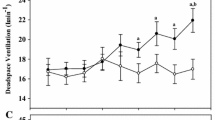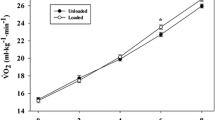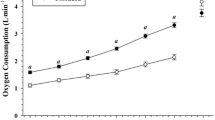Abstract
Purpose
We investigated the effect of carrying a 25 kg backpack upon exercise-induced respiratory muscle fatigue, pulmonary function and physiological and perceptual responses to exercise.
Methods
Nineteen healthy males performed 60 min walking at 6.5 km h−1 and 0 % gradient with a 25 kg backpack (load carriage; LC). Following 15 min recovery participants then completed a 2.4 km time trial with the load (LCTT) and on a different day, repeated the trials without the load [control trial (CON) and control time trial (CONTT), respectively]. Respiratory muscle fatigue was determined by the transient change in maximal inspiratory (P Imax) and expiratory (P Emax) pressure prior to and immediately following exercise.
Results
P Imax and P Emax were reduced from baseline by 11 and 13 % (P < 0.05), respectively, post-LC but remained unchanged post-CON. Following the time trial P Imax and P Emax were reduced 16 and 19 %, respectively, post-LCTT (P < 0.05) and by 6 and 10 %, respectively (P < 0.05), post-CONTT compared to baseline. Both forced vital capacity and forced expiratory volume in 1 s were reduced by 4 ± 13 and 1 ± 9 %, respectively, during LC when compared to CON. Relative to CON all physiological and perceptual responses were greater in LC, both post-LC and -LCTT (P < 0.01). Time trial performance was faster during CONTT (11.08 ± 1.62 min) relative to LCTT (15.93 ± 1.91 min; P < 0.05).
Conclusion
This study provides novel evidence that constant speed walking and time trial exercise with 25 kg thoracic load carriage induces significant inspiratory and expiratory muscle fatigue and may have important performance implications in some recreational and occupational settings.



Similar content being viewed by others
Abbreviations
- CON:
-
Control trial
- CONTT :
-
Control time trial
- FEV1 :
-
Forced expiratory volume in 1 s
- FVC:
-
Forced vital capacity
- [glucose]B :
-
Blood glucose
- HR:
-
Heart rate
- [lac−]B :
-
Blood lactate
- LC:
-
Load carriage trial
- LCTT :
-
Load carriage time trial
- PEF:
-
Peak expiratory flow
- P Imax :
-
Maximal inspiratory mouth pressure
- P Emax :
-
Maximal expiratory mouth pressure
- RER:
-
Respiratory exchange ration
- \(\dot{V}\) E :
-
Minute ventilation
- \(\dot{V}\)CO2 :
-
Carbon dioxide production
- \(\dot{V}\)O2 :
-
Oxygen consumption
References
Aliverti A (2008) Lung and chest wall mechanics during exercise: effects of expiratory flow limitation. Respir Physiol Neurobiol 163(1):90–99
Amann M (2011) Central and peripheral fatigue: interaction during cycling exercise in humans. Med Sci Sports Exerc 43(11):2039–2045
American Thoracic Society, European Respiratory Society (2002) ATS/ERS statement on respiratory muscle testing. Am J Respir Crit Care Med 166(4):518–624. doi:10.1164/rccm.166.4.518
American Thoracic Society, European Respiratory Society (2005) Standardisation of spirometry. Eur Respir J 26(2):319–338. doi:10.1183/09031936.05.00034805
Bastien GJ, Willems PA, Schepens B, Heglund NC (2005) Effect of load and speed on the energetic cost of human walking. Eur J Appl Physiol 94(1–2):76–83
Birrell SA, Haslam RA (2010) The effect of load distribution within military load carriage systems on the kinetics of human gait. Appl Ergon 41(4):585–590
Blacker SD, Williams NC, Fallowfield JL, Bilzon JL, Willems ME (2010) Carbohydrate vs protein supplementation for recovery of neuromuscular function following prolonged load carriage. J Int Soc Sports Nutr 7(1):1–11
Borg GA (1982) Psychophysical bases of perceived exertion. Med Sci Sports Exerc 14(5):377–381
Brown PI, McConnell AK (2012) Respiratory-related limitations in physically demanding occupations. Aviat Space Environ Med 83(4):424–430
Brown PI, Hughes MG, Tong RJ (2008) The effect of warm-up on high-intensity, intermittent running using nonmotorized treadmill ergometry. J Strength Cond Res 22(3):801–808
Brown PI, Sharpe GR, Johnson MA (2012) Inspiratory muscle training abolishes the blood lactate increase associated with volitional hyperpnoea superimposed on exercise and accelerates lactate and oxygen uptake kinetics at the onset of exercise. Eur J Appl Physiol 112(6):2117–2129
Butcher SJ, Jones RL, Mayne JR, Hartley TC, Petersen SR (2007) Impaired exercise ventilatory mechanics with the self-contained breathing apparatus are improved with heliox. Eur J Appl Physiol 101(6):659–669
Dominelli PB, Sheel AW, Foster GE (2012) Effect of carrying a weighted backpack on lung mechanics during treadmill walking in healthy men. Eur J Appl Physiol 112(6):2001–2012
Eves ND, Jones RL, Petersen SR (2005) The influence of the self-contained breathing apparatus (SCBA) on ventilatory function and maximal exercise. Can J Appl Physiol 30(5):507–519
Harms CA, Babcock MA, McClaran SR, Pegelow DF, Nickele GA, Nelson WB, Dempsey JA (1997) Respiratory muscle work compromises leg blood flow during maximal exercise. J Appl Physiol 82(5):1573–1583
Hodges PW, Butler JE, McKenzie DK, Gandevia SC (1997) Contraction of the human diaphragm during rapid postural adjustments. J Physiol 505(2):539–548
Hodges PW, Heijnen I, Gandevia SC (2001) Postural activity of the diaphragm is reduced in humans when respiratory demand increases. J Physiol 537(3):999–1008
Janssens L, Brumagne S, Polspoel K, Troosters T, McConnell A (2010) The effect of inspiratory muscles fatigue on postural control in people with and without recurrent low back pain. Spine 35(10):1088
Johnson MA, Sharpe GR, Brown PI (2007) Inspiratory muscle training improves cycling time-trial performance and anaerobic work capacity but not critical power. Eur J Appl Physiol 101(6):761–770
Knapik J, Harman E, Reynolds K (1996) Load carriage using packs: a review of physiological, biomechanical and medical aspects. Appl Ergon 27(3):207–216
Leddy JJ, Limprasertkul A, Patel S, Modlich F, Buyea C, Pendergast DR, Lundgren CE (2007) Isocapnic hyperpnea training improves performance in competitive male runners. Eur J Appl Physiol 99(6):665–676
Marcora S (2009) Perception of effort during exercise is independent of afferent feedback from skeletal muscles, heart, and lungs. J Appl Physiol 106(6):2060–2062
McClaran SR, Wetter TJ, Pegelow DF, Dempsey JA (1999) Role of expiratory flow limitation in determining lung volumes and ventilation during exercise. J Appl Physiol 86(4):1357–1366
Muza SR, Latzka WA, Epstein Y, Pandolf KB (1989) Load carriage induced alterations of pulmonary function. Int J Ind Ergon 3(3):221–227
Nadiv Y, Vachbroit R, Gefen A, Elad D, Zaretsky U, Moran D, Halpern P, Ratnovsky A (2012) Evaluation of fatigue of respiratory and lower limb muscles during prolonged aerobic exercise. J Appl Biomech 28(2):139
Pandolf KB, Givoni B, Goldman RF (1977) Predicting energy expenditure with loads while standing or walking very slowly. DTIC Document. http://oai.dtic.mil/oai/oai?verb=getRecord&metadataPrefix=html&identifier=ADA047699
Quanjer PH, Stanojevic S, Cole TJ, Baur X, Hall GL, Culver BH et al (2012) Multi-ethnic reference values for spirometry for the 3–95-yr age range: the global lung function 2012 equations. Eur Respir J 40(6):1324–1343
Rayson M, Holliman D, Belyavin A (2000) Development of physical selection procedures for the British Army. Phase 2: relationship between physical performance tests and criterion tasks. Ergonomics 43(1):73–105
Richmond VL, Rayson MP, Wilkinson DM, Carter JM, Blacker SD (2008) Physical demands of firefighter search and rescue in ambient environmental conditions. Ergonomics 51(7):1023–1031
Romer LM, McConnell AK (2004) Respiratory muscle training in healthy humans: resolving the controversy. Int J Sports Med 25:284–293
Romer LM, McConnell AK, Jones DA (2002) Effects of inspiratory muscle training on time-trial performance in trained cyclists. J Sports Sci 20(7):547–590
Romer LM, Lovering AT, Haverkamp HC, Pegelow DF, Dempsey JA (2006) Effect of inspiratory muscle work on peripheral fatigue of locomotor muscles in healthy humans. J Physiol 571(2):425–439
Ross E, Middleton N, Shave R, George K, McConnell A (2008) Changes in respiratory muscle and lung function following marathon running in man. J Sports Sci 26(12):1295–1301
Sheel AW, Romer LM (2012) Ventilation and respiratory mechanics. Compr Physiol 2(2):1093–1142
Shirley D, Hodges PW, Eriksson AEM, Gandevia SC (2003) Spinal stiffness changes throughout the respiratory cycle. J Appl Physiol 95(4):1467–1475
Tomczak SE, Guenette JA, Reid WD, McKenzie DC, Sheel AW (2011) Diaphragm fatigue after submaximal exercise with chest wall restriction. Med Sci Sports Exerc 43(3):416–424
Verges S, Lenherr O, Haner AC, Schulz C, Spengler CM (2007) Increased fatigue resistance of respiratory muscles during exercise after respiratory muscle endurance training. Am J Physiol-Regul Integr Comp Physiol 292(3):R1246–R1253
Volianitis S, McConnell AK, Koutedakis Y, McNaughton LR, Backx K, Jones DA (2001) Inspiratory muscle training improves rowing performance. Med Sci Sports Exerc 33(5):803–809
Wilson SH, Cooke NT, Edwards RH, Spiro SG (1984) Predicted normal values for maximal respiratory pressures in caucasian adults and children. Thorax 39(7):535–538
Conflict of interest
No conflicts of interest for each of the authors.
Ethical standards
All experimental procedures and methods of assessment used in this study were ethically approved by the host universities ethics committee and conform to the laws of the United Kingdom.
Author information
Authors and Affiliations
Corresponding author
Additional information
Communicated by Guido Ferretti.
Rights and permissions
About this article
Cite this article
Faghy, M.A., Brown, P.I. Thoracic load carriage-induced respiratory muscle fatigue. Eur J Appl Physiol 114, 1085–1093 (2014). https://doi.org/10.1007/s00421-014-2839-4
Received:
Accepted:
Published:
Issue Date:
DOI: https://doi.org/10.1007/s00421-014-2839-4




